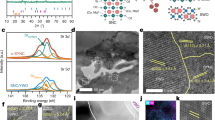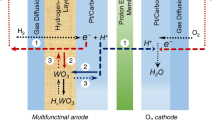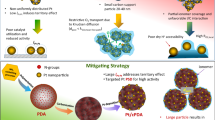Abstract
High energy efficiency and energy density, together with rapid refuelling capability, render fuel cells highly attractive for portable power generation1,2. Accordingly, polymer-electrolyte direct-methanol fuel cells are of increasing interest as possible alternatives to Li ion batteries3. However, such fuel cells face several design challenges and cannot operate with hydrocarbon fuels of higher energy density. Solid-oxide fuel cells (SOFCs) enable direct use of higher hydrocarbons4,5,6, but have not been seriously considered for portable applications because of thermal management difficulties at small scales, slow start-up and poor thermal cyclability. Here we demonstrate a thermally self-sustaining micro-SOFC stack with high power output and rapid start-up by using single chamber operation on propane fuel. The catalytic oxidation reactions supply sufficient thermal energy to maintain the fuel cells at 500–600 °C. A power output of ∼350 mW (at 1.0 V) was obtained from a device with a total cathode area of only 1.42 cm2.
This is a preview of subscription content, access via your institution
Access options
Subscribe to this journal
Receive 51 print issues and online access
$199.00 per year
only $3.90 per issue
Buy this article
- Purchase on Springer Link
- Instant access to full article PDF
Prices may be subject to local taxes which are calculated during checkout




Similar content being viewed by others
References
Heinzel, A., Hebling, C., Muller, M., Zedda, M. & Muller, C. Fuel cells for low power applications. J. Power Sources 105, 250–255 (2002)
Dyer, C. K. Fuel cells for portable applications. J. Power Sources 106, 31–34 (2002)
McGrath, K. M., Prakash, G. K. S. & Olah, G. A. Direct methanol fuel cells. J. Ind. Eng. Chem. 10, 1063–1080 (2004)
Perry Murray, E., Tsai, T. & Barnett, S. A. A direct-methane fuel cell with a ceria-based anode. Nature 400, 649–651 (1999)
Park, S., Vohs, J. M. & Gorte, R. J. Direct oxidation of hydrocarbons in a solid-oxide fuel cell. Nature 404, 265–267 (2000)
Tao, S. W. & Irvine, J. T. S. A redox-stable efficient anode for solid-oxide fuel cells. Nature Mater. 2, 320–323 (2003)
Dyer, C. K. A novel thin-film electrochemical device for energy conversion. Nature 343, 547–548 (1990)
Hibino, T. et al. A low-operating-temperature solid oxide fuel cell in hydrocarbon-air mixtures. Science 288, 2031–2033 (2000)
Liu, H., Ramnarayanan, R. & Logan, B. E. Production of electricity during wastewater treatment using a single chamber microbial fuel cell. Environ. Sci. Technol. 38, 2281–2285 (2004)
Stefan, I. C., Jacobson, C. P., Visco, S. J. & De Jonghe, L. C. Single chamber fuel cells: flow geometry, rate, and composition considerations. Electrochem. Solid-State Lett. 7, A198–A200 (2004)
Suzuki, T., Jasinski, P., Petrovsky, V., Anderson, H. U. & Dogan, F. Anode supported single chamber solid oxide fuel cell in CH4-air mixture. J. Electrochem. Soc. 151, A1473–A1476 (2004)
Hibino, T. et al. A solid oxide fuel cell using an exothermic reaction as the heat source. J. Electrochem. Soc. 148, A544–A549 (2001)
Napporn, T. W., Morin, F. & Meunier, M. Evaluation of the actual working temperature of a single-chamber SOFC. Electrochem. Solid-State Lett. 7, A60–A62 (2004)
Shao, Z. P. & Haile, S. M. A High-performance cathode for the next generation solid-oxide fuel cells. Nature 431, 170–173 (2004)
Ronney, P. D. Analysis of non-adiabatic heat-recirculating combustors. Combust. Flame 135, 421–439 (2003)
Shao, Z. P., Kwak, C. & Haile, S. M. Anode-supported thin-film fuel cells operated in a single chamber configuration. Solid State Ionics 175, 39–46 (2004)
Shukla, A. K., Jackson, C. L., Scott, K. & Raman, R. K. An improved-performance liquid-feed solid-polymer-electrolyte direct methanol fuel cell operating at near-ambient conditions. Electrochem. Acta 47, 3401–3407 (2002)
Thomas, S. C., Ren, X. M., Gottesfeld, S. & Zelenay, P. Direct methanol fuel cells: progress in cell performance and cathode research. Electrochem Acta 47, 3741–3748 (2002)
Hibino, T., Ushiki, K. & Kuwahara, Y. New concept for simplifying SOFC system. Solid State Ionics 91, 69–74 (1996)
Koh, J. H., Kang, B. S., Lim, H. C. & Yoo, Y. S. Thermodynamic analysis of carbon deposition and electrochemical oxidation of methane for SOFC anodes. Electrochem. Solid-State Lett. 4, A12–A15 (2001)
Acknowledgements
We thank D. Goodwin and Y. Hao of Caltech for discussions.This work is funded by the Defense Advanced Research Projects Agency, Microsystems Technology Office. Additional support has been provided by the National Science Foundation through the Caltech Center for the Science and Engineering of Materials.
Author information
Authors and Affiliations
Corresponding author
Ethics declarations
Competing interests
Reprints and permissions information is available at npg.nature.com/reprintsandpermissions. The authors declare no competing financial interests.
Supplementary information
Supplementary Discussion
An analysis of the influence of heat recirculation on thermal self-sustainability of the fuel cells is presented. (PDF 9 kb)
Supplementary Figure S1
Impedance spectra of both a single cell and the fuel cell stack are presented, along with a detailed legend. (PDF 27 kb)
Supplementary Figure S2
The conductivity of Sm0.15Ce0.85O1.925 prepared by three different methods is compared. (PDF 29 kb)
Supplementary Figure S3
Images of as-prepared fuel cells are presented. (PDF 188 kb)
Supplementary Figure S4
A thermodynamic analysis of the conditions under which carbon deposition is expected is presented. (PDF 62 kb)
Supplementary Figure S5
These images show the extent of carbon coking on fuel cells exposed to various conditions, and the role of the catalyst in preventing coking. (PDF 55 kb)
Rights and permissions
About this article
Cite this article
Shao, Z., Haile, S., Ahn, J. et al. A thermally self-sustained micro solid-oxide fuel-cell stack with high power density. Nature 435, 795–798 (2005). https://doi.org/10.1038/nature03673
Received:
Accepted:
Issue Date:
DOI: https://doi.org/10.1038/nature03673
This article is cited by
-
Impact of La doping on the crystalline phase and mixed ionic-electronic conductivities of Ba0.5−xLa0.5+xFeO3−δ (0≤x≤0.3) solid solution
Journal of Materials Science: Materials in Electronics (2023)
-
Designing Oxide Catalysts for Oxygen Electrocatalysis: Insights from Mechanism to Application
Nano-Micro Letters (2023)
-
Enhanced redox and reoxidation tolerances of Ce0.8Gd0.2O1.9 electrolyte for Ni cermet anodes in single-chamber SOFCs
Journal of Solid State Electrochemistry (2022)
-
Fuel Cell Reactors for the Clean Cogeneration of Electrical Energy and Value-Added Chemicals
Electrochemical Energy Reviews (2022)
-
Electrochemical properties of Sr-doped layered perovskite as a promising anode material for direct hydrocarbon SOFCs
Journal of the Korean Ceramic Society (2020)
Comments
By submitting a comment you agree to abide by our Terms and Community Guidelines. If you find something abusive or that does not comply with our terms or guidelines please flag it as inappropriate.



